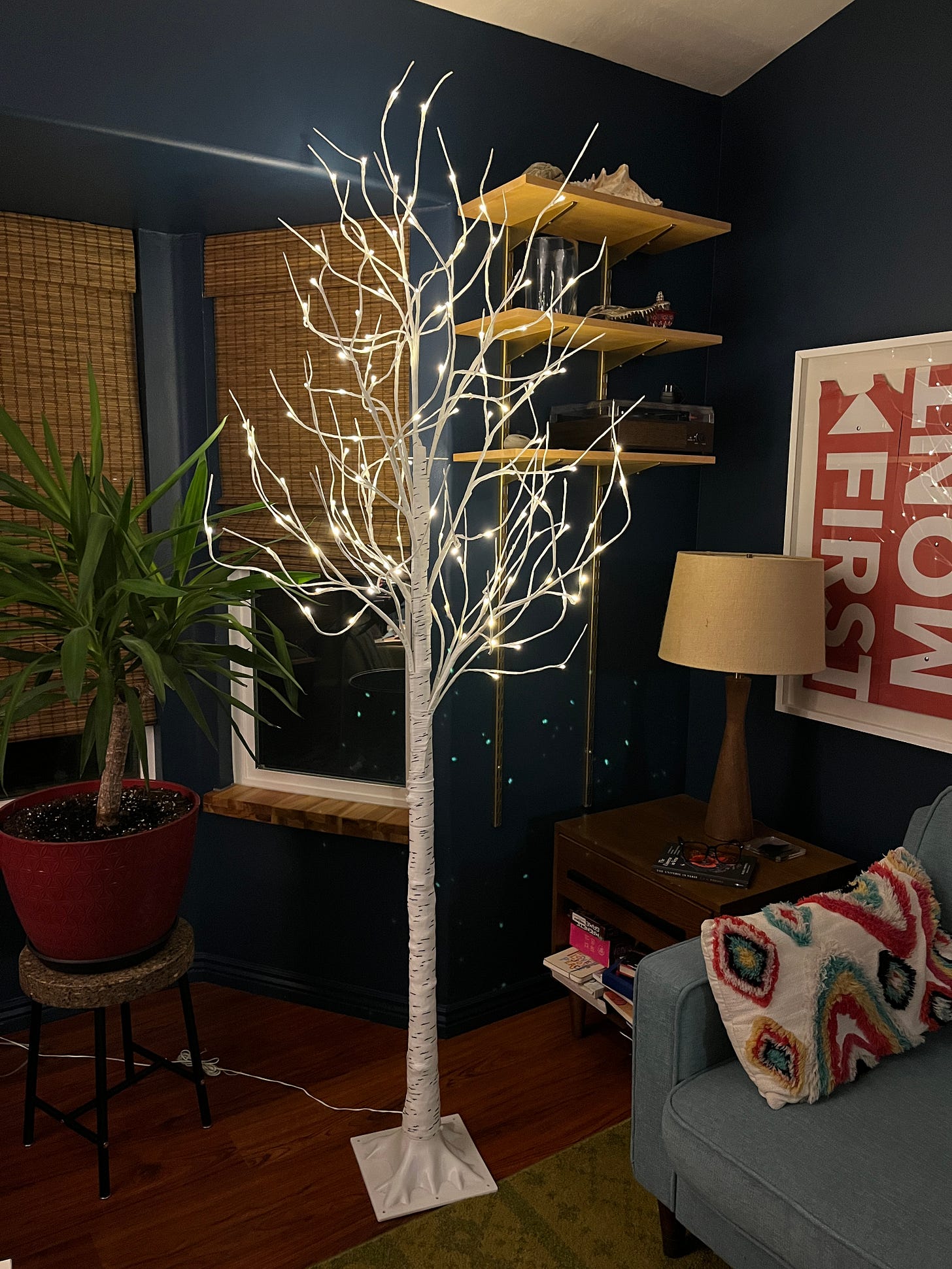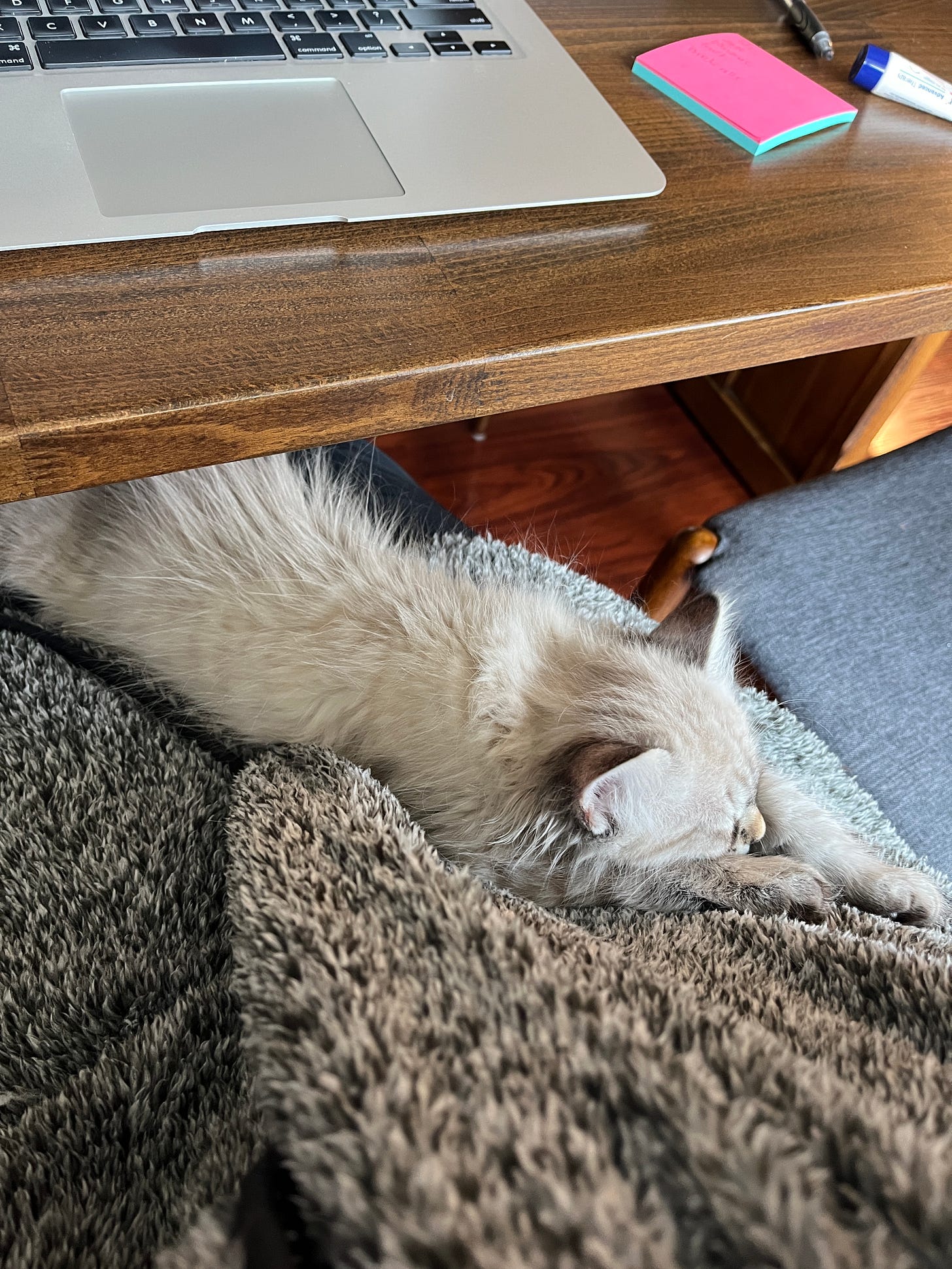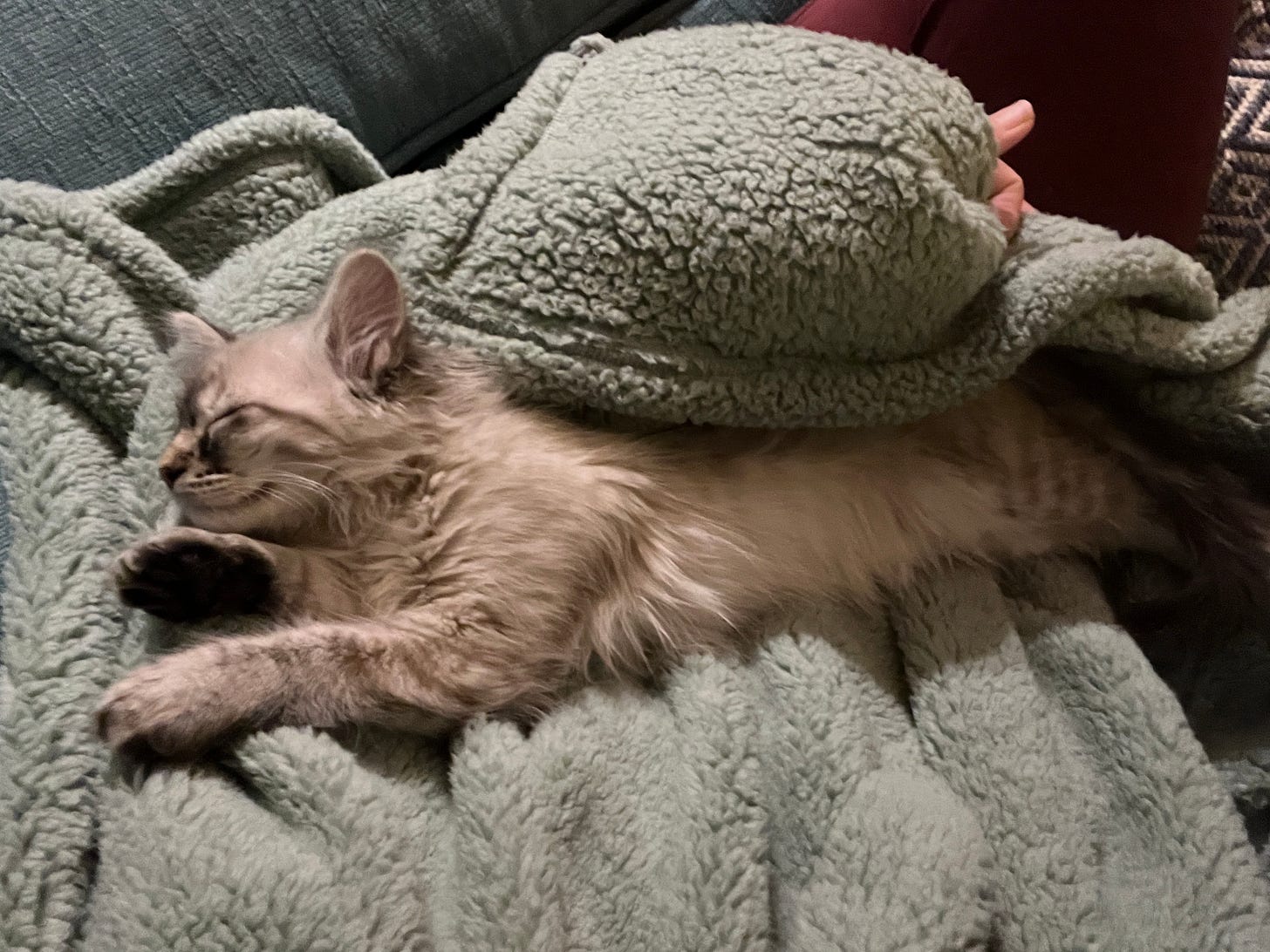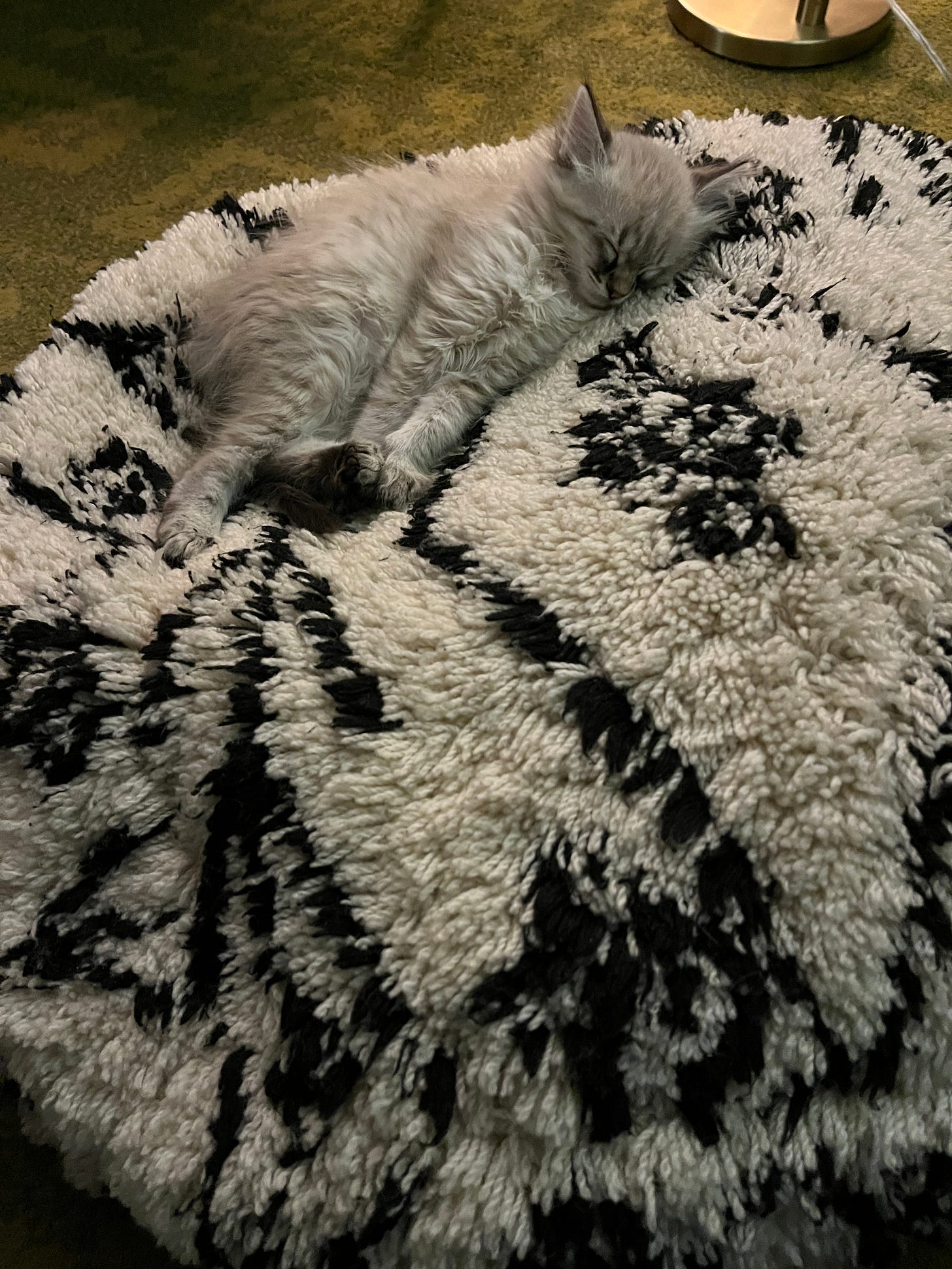I just looked over to the bedside table and saw a tissue, wilting from the box like a dead flower, laid gently to rest on the surface of my tea. Welcome to winter.
I have been very busy this past month. I have been deeply engaged in the practice of wintering. It is a thoughtful, concentrated intensive that has put me in a continual condition of consideration and contemplation. It’s been a focused effort to align myself with my surroundings, to set my inner clock to the new time and prepare for the quiet spell cast by the change, the dark, the stillness, and all that winter is.
Here is what my wintering has been looking like this January. It begins by setting the scene.
First, the hygge.
As soon as the Christmas tree is gone, we pull out Winter Tree, a tall lit up birch tree with branches to bend.
Accompanying this is the paper snow star. Soft blankets are folded in place, couch ottomans positioned, cats nearby at the ready. A designated meetingplace to wind down and discuss the day.
Second, the books. I read three books in January which is pretty good for me. One was The Year of Living Danishly by Helen Russell. Long have I admired the Nordic peoples and Scandinavian ways. I just feel like they hold a lot of answers, have figured out a lot of things, and I look to them as my wintering gurus.
Another book, and the source from which I borrowed the title for this, was Wintering: The Power of Rest and Retreat During Difficult Times by Katherine May. I loved this book because she seemed to think like I do and I’ve added her to my list of best friends I’ve never met, a rare and invaluable kinsperson.
She defined wintering as,
“A season in the cold. A fallow period in life when you’re cut off from the world, feeling rejected, sidelined, blocked from progress, or cast into the role of an outsider.“
Or wintering can be the times when a person finds themself,
“in a period of transition and have temporarily fallen between two worlds. Some winterings creep upon us more slowly, accompanying the protracted death of a relationship, the gradual ratcheting up of caring responsibilities as our parents age, the drip-drip-drip of lost confidence. Some are appallingly sudden, like discovering one day your skills are considered obsolete, the company you worked for has gone bankrupt, or your partner is in love with someone new. However it arrives, wintering is usually involuntary, lonely, and deeply painful.”
I am deeply acquainted with this kind of metaphorical wintering. I think it even goes hand-in-hand with the way I approach the season—times to pull back, retreat. I’ve spent so many years preparing for and laboring at winters of so many types and varieties that my relationship with them has become intimate, reconciliatory, almost symbiotic. I’ve learnt to lean in.
Upon winter, we enter a new routine of daily life. On the surface, it consists of thick socks, new books, movie watching, warm breakfasts of oat porridge and rye toast, cozy cat time, habitual homework and hearth hobbies.
But beneath that are the deeper layers of wintering that are hard to define: The quieting. The pausing. The slowing. The noticing. The shift of internal clocks. The increased sleeping and the accompaniment of wild dreams. It’s very small things that combine to form a deliberately altered state of mind, a place to enter into.
It’s texting completely unrelated, unnecessary messages just for a reminder of humanity, like the one to the office of my hormone NP saying, “This is weird but please tell Sally I’m pretty sure she was in my dream last night. I have a goal to inform people who feature in my dreams.” I got a laugh and a promise to forward the message. Sally said she hoped it was a good dream and not a nightmare. I told her it felt like an adventure dream, and I got the feeling she was something like a superhero, which made a lot of sense.
It’s Sunday brunches with hot chocolate and heated debates to keep us warm on nights too cold to even be considered safe.
It’s the winter relief, knowing I get a break from fighting the heat and can sleep more easily, it coming more readily in chilled darkened rooms and a chance to burrow into bedclothes.
It’s joining a Facebook group called Hygge Home where you get to see people’s photos of their cozy-making wherever they live. Places like northern Canada, Scotland, or Puget Sound where people near the water watch orcas and other sea creatures show up near their hygge home, in wintering cycles of their own, of which I am deeply jealous.

It’s gazing at photos of the “blue hour” of snowy places, where the setting sun hits the snow at the right moment, casting a blue glow over the snowscape. And then afterward, noticing a precious blue hour of your own on that one precious day it snowed, giving off a light so ethereal, you stop what you’re doing to go to the window. And other things not available in summer.
Like noticing the wintering murmurations of starlings who fly in cloud clusters moving fluidly like a globular entity, alive, pulsing and shape-shifting across the sky. They’re amazing. My friends, the January geese who I always listen for as they pass by. Other winter birds, other winter life teeming in other, subtler ways that require a special winter eye to detect.
I stood in a museum in London last summer learning about birds and animals that enter into a torpor state in winter. They fatten themselves up and then slow their body temp and heart rate so slowly, it’s like a self-induced coma. Three beats/minute sometimes. Some break out of it midway through to make sure their homes are secure and they are otherwise safe, but they slip back into it at just the right time in exactly the right way so that they don’t push too hard, go too far and accidentally starve or freeze to death.
This is something to abide by, to consider as we winter. There is a natural slowing down that winter requires. Pets, particularly cats, are really good wintering companions. I have struggled to get anything done this month because they force me to stop and pay attention to their need for rest at regular intervals. I’ve learned to look to them as guides. “You’re right, rest is important.”
I’ve spent the entire January preparing for each day by donning a fleece jacket or some other fuzzy fabric so that when I am inevitably forced to drop everything and give them the warm lap that is apparently necessary for napping, it can be as comfy as possible. I try to remember to have something to read nearby, otherwise thinking thoughts and window-gazing are, again, the order of the day.
One night I walked into the cozy lair with the cats and tree lights and said, “I suppose we’ll eventually get sick of being indoors all the time…” and trailed off as Julian concurred that that was not this day, contented are we.
Julian goes on daily winter walks when the light is just right. He is sure to go at exactly the right moment if he can afford time. He bundles up in a hat, gloves, jacket, coat, and lightweight summer shorts. He walks his 3-mile route listening to his things and applying them as soundtracks to the path he walks.
Sometimes I squirrel away things to save for winter. This would be fun to do now but I’m going to save it for the winter. Even though I’m naturally much more inclined to be the grasshopper instead of the ant in the cautionary fable.
Like taking a new class that forces me to leave my home. Sean and I go to a weekly ASL class and I am fascinated by the components of this kind of language. I love how important it is to emote, using facial expressions, which feels like using emojis, which I have long believed to be just as contributive as words. And combining that with movement and body parts as tools and canvas or paper. It’s dance and art and all manner of expression that I don’t know I’ll ever be fluent in but it breaks our brains and the learning hurts so good. We attempt this language with strangers and come home absolutely knackered.
Wintering is poetry readings in upstairs rooms in bookstores and theological lectures in art galleries, opting for the cushioned window bench rather than the folding chair that was set out. Then having dinner at 7:30, which feels like midnight, in a cozy lowlit restaurant that serves root vegetables, pork schnitzel and chive mashed potatoes.
It’s after-dinner Barnes & Noble trips to take stock of books that look interesting and to browse the magazine area, selecting one on baking or interior design just to be inspired, in my constant attempt to emulate the Danes, a “design society,” surrounding themselves with beautiful things.
Wintering involves some kind of strange reflexive substitution, where everything unnecessary becomes muted and everything good and needed becomes amplified.
But it’s important to recognize this need and to opt in rather fight it or believe life should be lived just as it’s always been. Nature doesn’t fight winter or pretend it isn’t happening, why should we? Let us adapt.
In her book, May says,
“Doing those deeply unfashionable things—slowing down, letting your spare time expand, getting enough sleep, resting—is a radical act now, but it is essential. This is a crossroads we all know, a moment when you need to shed a skin. If you do, you’ll expose all those painful nerve endings and feel so raw that you’ll need to take care of yourself for a while. If you don’t, then that skin will harden around you. It’s one of the most important choices you’ll ever make.”
“Wisdom resides in those who have wintered.”
This is what the Nordic people have figured out, I am certain. They miss the sun, yes, but they honor its departure rather than lament.
May states,
”We’ve moved a long way away from the time when we saw a recuperative break as a legitimate strategy to aid our recovery. I wonder if there’s any room left for recovery at all. We are either off or on.”
I wonder if we need to self-induce a kind of coma in order to find the reset and renewal we need. In her book, May talks about a friend of hers who fell into a coma at age 18 after contracting bacterial meningitis. When she woke up she was unable to leave her hospital bed or even chew her food.
”But something had happened in the intervening hours which made it possible to endure the months of recovery that followed. She’d been immersed in an incredible dream in which she had been falling through darkness but heard the sound of singing and it lifted her up and carried her to a place she could wait in safety.
She returned to everyday life knowing that she was different from all the other people her age: she was no longer afraid of death, which now seemed to her a benign process. She also had a renewed sense of focus and determination, which came from knowing how short life could be. Whenever I speak to her about it I get the sense that she’s had more contact with the life cycle than the rest of us. She knows what it is to cast off an old skin and grow a new one.”
The song Winter Skin by Jars of Clay, a favorite this time of year, is very simple, and prescribes only these lines:
We put on our winter skin, our winter skin, and walk,
We put on our winter skin, our winter skin, and walk,
And we watch the snowfall.
This is a good summary of what I have been doing. Very busy, yes. Very busy in winter.














I love it, thank YOU! Yes and yes. There definitely seems to be a certain kind of winteral (it’s a word) energy and the more aligned I am to it, the better.
This post made me feel all the winter feels. 6 years ago I moved to Oregon and finally got to experience 4 seasons and I have come to truly love each season for what it brings. Winter is when I feel the most at peace (rain makes me the happiest) because I finally get an excuse to slow down and reflect. My wife (the extrovert) constantly tries to fill our schedule with people and activities in the winter to help her mood, but I (the introvert) keep trying to tell her that nature wants us to slow down in the winter to recharge our batteries so we can enter in to the new season renewed and energized. You probably didn’t need to know all of this, but what I really wanted to say was thank you for this post. It was beautiful and made my cozy winter day.